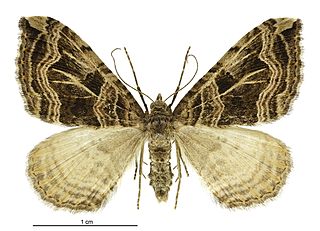
Xanthorhoe semifissata, commonly known as the barred pink looper. is a moth of the family Geometridae. It is endemic to New Zealand and is found throughout the country although it is much less common in the mountains in the south and west of the South Island. The larvae host plants include Nasturtium officinale as well as species in the Cardamine genus. Adult moths inhabit shrubs at the edge of native forest.

Asaphodes is a genus of moths in the family Geometridae erected by Edward Meyrick in 1885. This genus is endemic to New Zealand and species within this genus are found throughout New Zealand including the North, South and Stewart / Rakiura Islands.
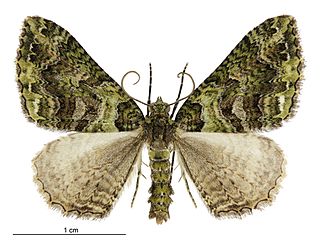
Austrocidaria similata is a species of moth of the family Geometridae. It is endemic to New Zealand and is found throughout the country including on off shore and sub Antarctic Islands. This species inhabits native forest and shrubland. Eggs are while in appearance and oval in shape and take approximately three weeks to mature. Larvae mimic the appearance of a moss covered twig and feed on Coprosma species. It has been hypothesised that this species overwinters as larvae. The larvae pupate on the ground with the pupa being enclosed in a thin cocoon made up of silk and refuse. Adults are on the wing all year but are most commonly observed from October until March. Adults are nocturnal and are attracted to light. During the day they can be observed resting on tree trunks where its forewing colouration provides camouflage protection from predators.

Asaphodes aegrota is a species of moth in the family Geometridae. It was first described by Arthur Gardiner Butler in 1879 as Selidosema aegrota. It is endemic to New Zealand and can be found in the North, South and Stewart Islands. This species inhabits open spaces in lowland native forest. The larvae of A. aegrota feed on native herbs and have also been observed feeding of the introduced lawn daisy. The adults are variable in appearance with the markings on both sides of its wings varying in intensity. Some populations also have narrow winged females. Adults are on the wing from November until March.

Asaphodes albalineata is a species of moth in the family Geometridae. It is endemic to New Zealand and has been observed on Stewart Island / Rakiura. This species is similar in appearance to Asaphodes oraria but can be distinguished as it has an unusual pattern on the underside of its hindwings. It inhabits open hill tops and adults are on the wing in December.
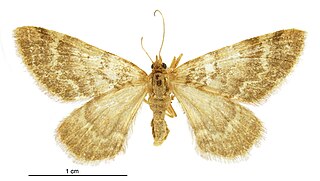
Asaphodes aphelias is a species of moth in the family Geometridae. It is endemic to New Zealand and has been observed in Fiordland. This species inhabits damp native scrub and has been observed in upland wetlands at altitudes of between 800 and 1100 m. Adults are on the wing in February but the female of this species is unusual as it has narrow fore and hind wings.

Asaphodes beata is a species of moth in the family Geometridae. It is endemic to New Zealand and is a relatively common species that can be found throughout the country in native forest or scrub habitat. It can be distinguished from its close relative Asaphodes adonis by the colour of its hind wings. The larvae of this species feeds on watercress but tends to be inactive during the day. If threatened it will mimic a twig dropping to the ground. The adult moths are on the wing from October to March and are said to be attracted to white rātā. The white markings on the forewing of the adults are variable in appearance.

Asaphodes chlamydota is a moth in the family Geometridae. It is endemic to New Zealand, and can be found in the lower part of the North Island and in the South Island. It inhabits native forest and shrublands. The larvae of this species feeds on native Clematis plants including Clematis afoliata. Adults are on the wing from November to April and are regarded as having intermedia flight powers.

Asaphodes imperfecta is a moth in the family Geometridae. It is endemic to New Zealand and is found in the southern part of the South Island. The species inhabits low lying swampy native forest. The host plants of the larvae of this species is unknown. The adults are on the wing in December and January. It is classified as critically endangered by the Department of Conservation.

Asaphodes obarata is a moth in the family Geometridae. It is endemic to New Zealand and has been collected in both the North and South Islands. It seems to inhabit the margins of native forest and also frequents plains, with an affinity for gorse hedges. The host plants of the larvae of this species are unknown. The adults are on the wing in December and January. It is classified as critically endangered by the Department of Conservation. There has been a contraction of range of A. obarata with it now being regarded as locally extinct in both Dunedin and Invercargill.

Asaphodes chlorocapna is a species of moth in the family Geometridae. This species is endemic to New Zealand and can only be found in the Chatham Islands. The larvae of this species consume the leaves of Muehlenbeckia plants. Adults are on the wing in January. This species is classified as "At Risk, Relict'" by the Department of Conservation.

Asaphodes cinnabari is a species of moth in the family Geometridae. This species is endemic to New Zealand and can be found in Otago and Southland where it lives in alpine swampy habitat. Adults of this species are on the wing in November.

Asaphodes clarata is a species of moth in the family Geometridae. This species is endemic to New Zealand and has been found on the North and South Islands. The species inhabits open grassy areas, including tussock grasslands, in montane habitat. The larvae feed on the leaves of Ranunculus species. The adult moths are day flying and are on the wing from December to February and have been shown to pollinate Celmisia laricifolia and Hebe pinguifolia.
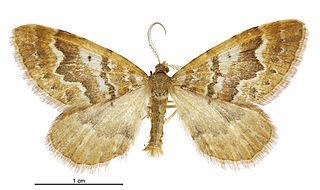
Asaphodes exoriens is a species of moth in the family Geometridae. This species is endemic to New Zealand and has been found in Central Otago. This is an alpine species and frequents open grassy habitat. They can also be found in upland wetland habitat at altitudes between 800 and 1100 m. Adults are on the wing in March.
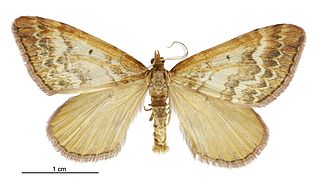
Asaphodes helias is a species of moth in the family Geometridae. It is endemic to New Zealand. It has been found in the middle and southern parts of the South Island. This species frequents tussock and scrubby habitat. The host plants of the larvae of this species include Cardamine and Ranunculus species. They have also been witnessed feeding on exotic buttercup species in the genus Bellis. Adults are on the wing in January and February.
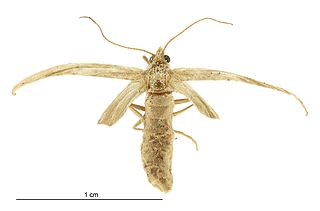
Asaphodes oraria is a species of moth in the family Geometridae. This species is endemic to New Zealand and has been observed in the southern South Island and on Stewart Island / Rakiura. The male is pale yellow coloured and the female has severely reduced wings and is flightless. The habitat of this species is tussock grasslands on coastal sand dunes and in the mountains at elevations of approximately 4,000 ft. The larvae have adapted to feeding on exotic lawn daisy species in the genus Bellis. The adults of this species are on the wing from November to April.
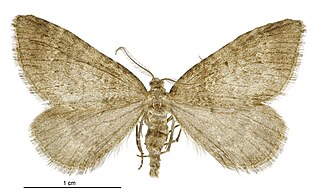
Asaphodes periphaea is a moth in the family Geometridae. It is endemic to New Zealand and has only been collected in the mountains near Lake Wakatipu in the South Island. The male is fuscous coloured sprinkled with whitish colouration. The female is brachypterous. The preferred habitat of this species are alpine bluffs as well as mountainous open country. This species is on the wing from January to March.

Asaphodes prasinias is a moth in the family Geometridae. It is endemic to New Zealand and has been found on both the North and South Islands. This species inhabits native forest including beech forest and subalpine scrub. The range of this species has reduced as this species is regarded as being locally extinct in the previously inhabited open non-forest habitats around Invercargill. Adults are on the wing from November to January.

Asaphodes recta is a moth in the family Geometridae. It is endemic to New Zealand and is found in the southern parts of the South Island. The preferred habitat of this species is open tussock grassland. The adults are on the wing in February and March. Larvae of this species have been reared on species in the genera Ranunculus and Bellis.

Asaphodes sericodes is a moth in the family Geometridae. It is endemic to New Zealand and has been observed in the southern parts of the South Island. This species inhabits open tussock grasslands in subalpine scrub or wetlands. The female of the species is likely semi-apterous and is flightless. The adult males are on the wing in January.























